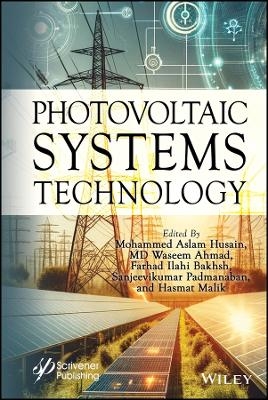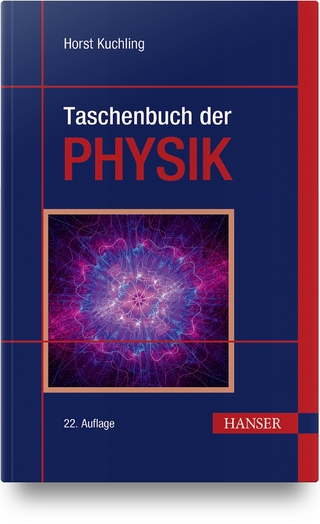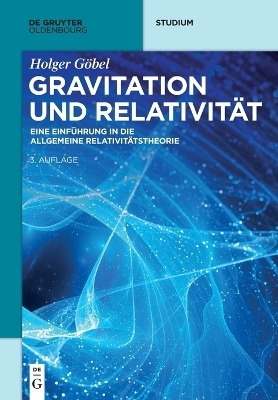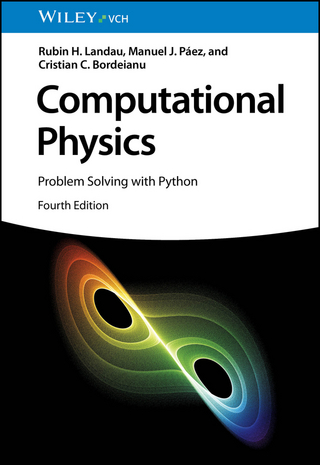
Photovoltaic Systems Technology
Wiley-Scrivener (Verlag)
978-1-394-16642-8 (ISBN)
- Titel ist leider vergriffen;
keine Neuauflage - Artikel merken
A huge number of research articles and books have been published in the last two decades, covering different issues of PV efficiency, circuits, and systems for power processing and their related control. Books that have been published cover one or more topics but altogether fail to give a complete picture of the different aspects of PV systems. Photovoltaic Systems Technology aims to close the gap by providing a comprehensive review of techniques/practices that are dedicated to improving the performance of PV systems.
The book is divided into three parts: the first part is dedicated to advancements in power electronic converters for PV systems; tools and techniques for maximum power point tracking of PV systems will be covered in the second part of the book; and the third part covers advancements in techniques for solar PV forecasting. The overall focus of the book is to highlight the advancements in modeling, design, performance under faulty conditions, forecasting, and application of solar photovoltaic (PV) systems using metaheuristic, evolutionary computation, machine learning, and AI approaches. It is intended for researchers and engineers aspiring to learn about the latest advancements in solar PV technology with emphasis on power electronics involved, maximum power point tracking (MPPT) schemes, and forecasting techniques.
Mohammed Aslam Husain, PhD, is an assistant professor in the Department of Electrical Engineering, Rajkiya Engineering College, Ambedkar Nagar, India. He has previously worked as Head of the Electrical Engineering Department at the University Polytechnic, Integral University, India, and as Assistant Professor in the Department of Electrical Engineering at Aligarh Muslim University, India. He was the recipient of the Institution of Engineers (India) Young Engineers Award for 2022-23 and the Young Scientist Award for 2017 from the Council of Science and Technology, Uttar Pradesh, India. He has authored over 60 scientific papers. MD Waseem Ahmad, PhD, is an assistant professor at the National Institute of Technology Karnataka, Surathkal, India. He previously worked as a research fellow in the Department of Electrical and Computer Engineering, National University of Singapore, Singapore, and as a graduate trainee engineer with Siemens Ltd., New Delhi, India. Additionally, he has published more than 20 papers in across various Institute of Electrical and Electronics Engineers journals and conferences. Farhad Ilahi Bakhsh, PhD, is an assistant professor in the Department of Electrical Engineering, National Institute of Technology Srinagar, Jammu and Kashmir, India. He has developed five new systems for grid integration of wind energy, four of which have been patented between India and Australia. He has more than 50 published papers in reputed national and international journals and conferences. Sanjeevikumar Padmanaban, PhD, is a faculty member with the Department of Energy Technology, Aalborg University, Esbjerg, Denmark. He has authored over 300 scientific papers. He is a fellow of the Institution of Engineers, India, the Institution of Electronics and Telecommunication Engineers, India, and the Institution of Engineering and Technology, U.K. Hasmat Malik, PhD, is a Senior Lecturer in the Department of Electrical Power Engineering, Faculty of Electrical Engineering, Universiti Teknologi Malaysia (UTM), Malaysia, as well as a Chartered Engineer (CEng) and a Professional Engineer (PEng). His research findings related to intelligent data analytics, artificial intelligence, and machine learning applications in power systems, power apparatus, smart buildings and automation, smart grid, forecasting, prediction, and renewable energy sources have been widely published in international journals and conferences. He has also authored and co-authored more than 100 WoS research papers.
List of Contributors xiii
Preface xvii
1 History of Solar PV System and its Recent Development 1
Vaishali Gautam, Shahida Khatoon and Mohd Faisal Jalil
1.1 Introduction 1
1.2 Solar Photovoltaic (PV) 3
1.3 Historical Overview 4
1.4 Grid-Connected PV System 5
1.5 Power Losses in PV System 13
1.6 Different MPPT and Solar Tracker 16
1.7 Development in Standalone PV System 18
1.8 The Development and Challenges in DC--DC Converter for PV Applications 18
1.9 PV-Powered Electric Vehicles 20
1.10 Discussion 21
1.11 Conclusion 22
2 Evolution and Modeling of Solar Photovoltaic Cells: From Early to Modern Concepts 27
Mohammad Shahabuddin, Mohammed Asim and Adil Sarwar
2.1 Introduction 28
2.2 History of Solar Cell 29
2.3 Solar PV Cell Formation 31
2.4 Solar Cell Models 37
2.5 Applications 39
2.6 Conclusion 40
3 Clustering of Panels and Shade Diffusion Techniques for Partially Shaded PV Array--Review 43
Vaishali Gautam, Shahida Khatoon, Mohd Faisal Jalil and Naimul Hasan
3.1 Introduction 44
3.2 Reconfiguration of PV Array 46
3.3 Classification of Reconfiguration Strategies 47
3.4 Conclusion 56
4 Advances in Solar PV-Powered Electric Vehicle Charging System 63
Rashid Ahmed Khan, Noorul Islam, Seerin Ahmad, Bushra Sabir, Mohammed Aslam Husain and Hwa-Dong Liu
4.1 Introduction 64
4.2 Overview of Electric Vehicle (EV) Charging System 65
4.3 Evolution of Electric Vehicles 66
4.4 Classification of Electric Vehicle (EV) Charging Stations 67
4.5 Approaches to PV-EV Charging System 68
4.6 Recharging and Innovative Methods 71
4.7 Energy Storage Systems for EV Charging 74
4.8 Hybrid Energy Storage Technologies to Reduce the Size of the Battery 74
4.9 Battery Management System (BMS) 77
4.10 Conclusion and Future Aspects 78
5 A Review of Maximum Power Point Tracking (MPPT) Techniques for Photovoltaic Array Under Mismatch Conditions 85
Dushyant Sharma, Mohd Faisal Jalil, Mohd Shariz Ansari and R. C. Bansal
5.1 Introduction 86
5.2 Evaluation of MPPT Techniques 87
5.3 Conclusion 97
6 Metaheuristic Techniques for Power Extraction from PV-Based Hybrid Renewable Energy Sources (HRESs) 103
Akhlaque Ahmad Khan and Ahmad Faiz Minai
6.1 Introduction 104
6.2 Hybrid Renewable Energy Systems 107
6.3 PV Array Characteristics 109
6.4 Evaluation of Various MPPT Methods Using Standard Conventional Approaches 111
6.5 Evaluation of Various MPPT Methods Using Advanced Approaches (Metaheuristic Optimization Approaches) 113
6.6 Conclusion and Future Scope 116
7 Intelligent Modeling and Estimation of Solar Radiation Data Using Artificial Intelligence 123
Ahmad Neyaz Khan, Sarosh Patel, Asif Khan, Asad Malik, Mohd Fazil and Saqib Qamar
7.1 Introduction 124
7.2 The Solar-AI Span: Background and Literature Review 126
7.3 Modeling and Prediction of Data on Solar Irradiance Using AI Approaches 135
7.4 Detailed Comparative Analysis of Different AI Approaches Used in Modeling and Forecasting of Data on Solar Radiation 138
7.5 Discussion 143
7.6 Conclusion 144
8 Application of ANN--ANFIS Model for Forecasting Solar Power 151
Gulnar Perveen, Priyanka Anand and Amod Kumar
8.1 Introduction 152
8.2 Overview of ANN 156
8.3 ANFIS Architecture 157
8.4 Characterization of Solar Plant 158
8.5 Classification of Weather Condition 159
8.6 Statistical Performance Indicators 160
8.7 Development of ANN--ANFIS Model 161
8.8 Results 162
8.9 Conclusions 171
9 Machine Learning Application for Solar PV Forecasting 177
Asif Khan, Mohd Khursheed, Jian Ping Li, Farhan Ahmad and Ahmad Neyaz Khan
9.1 Introduction 177
9.2 Literature Review 179
9.3 Research Methods and Materials 181
9.4 Proposed Work 182
9.5 Experimental Simulation, Result Analysis, Comparison, and Discussion 184
9.6 Conclusion 188
10 Techno-Economic Comparative Analysis of On-Ground and Floating PV Systems: A Case Study at Gangrel Dam, India 191
Satya Prakash Makhija, Pankaj Kumar Shrivastava, Prasanta Kumar Jena, Satya Prakash Dubey and Pushpendra Singh
10.1 Introduction 193
10.2 Project Site Assessment for Various Parameters 197
10.3 Design of On-Ground and Floating PV Systems 199
10.4 Simulation, Results and Analysis 201
10.5 Conclusion 207
11 BLDC Motor Driven Water Pumping System Powered by Solar Photovoltaics (PV) 211
Dileep Kumar, Md Tabrez, Surya Deo Choudhary and Farhad Muhsin Mahmood
11.1 Introduction 212
11.2 Interaction of PV Array and Load 213
11.3 Application of DC--DC Converter for MPPT 214
11.4 Three-Phase BLDC Motor 215
11.5 Simulation of Suggested Technique 218
11.6 Conclusion 221
12 Hybrid Photovoltaic/PEM Fuel Cell Driven Water Pumping System for Agricultural Application: Overview, Challenges and Future Perspectives 225
Rupendra Kumar Pachauri, Renu Mavi, Ahmad Faiz Minai, Shubham Tiwari and Shashikant
12.1 Introduction 226
12.2 Mathematical Modeling 229
12.3 MATLAB/Simulink Study of Hybrid FC/PV Powered Water Pumping System 231
12.4 Electrical Water Pumping System Categories 236
12.5 Challenges of Hybrid PV/PEMFC Technology 240
12.6 Future Scope of Hybrid PV/PEMFC Water-Pumping Systems 243
12.7 Pros and Cons of Hybrid PV/PEMFC-Powered Water-Pumping System 244
12.8 Conclusion 246
References 246
Index 251
| Erscheinungsdatum | 04.06.2024 |
|---|---|
| Sprache | englisch |
| Gewicht | 631 g |
| Themenwelt | Naturwissenschaften ► Physik / Astronomie |
| Technik ► Elektrotechnik / Energietechnik | |
| Technik ► Maschinenbau | |
| ISBN-10 | 1-394-16642-7 / 1394166427 |
| ISBN-13 | 978-1-394-16642-8 / 9781394166428 |
| Zustand | Neuware |
| Informationen gemäß Produktsicherheitsverordnung (GPSR) | |
| Haben Sie eine Frage zum Produkt? |
aus dem Bereich


